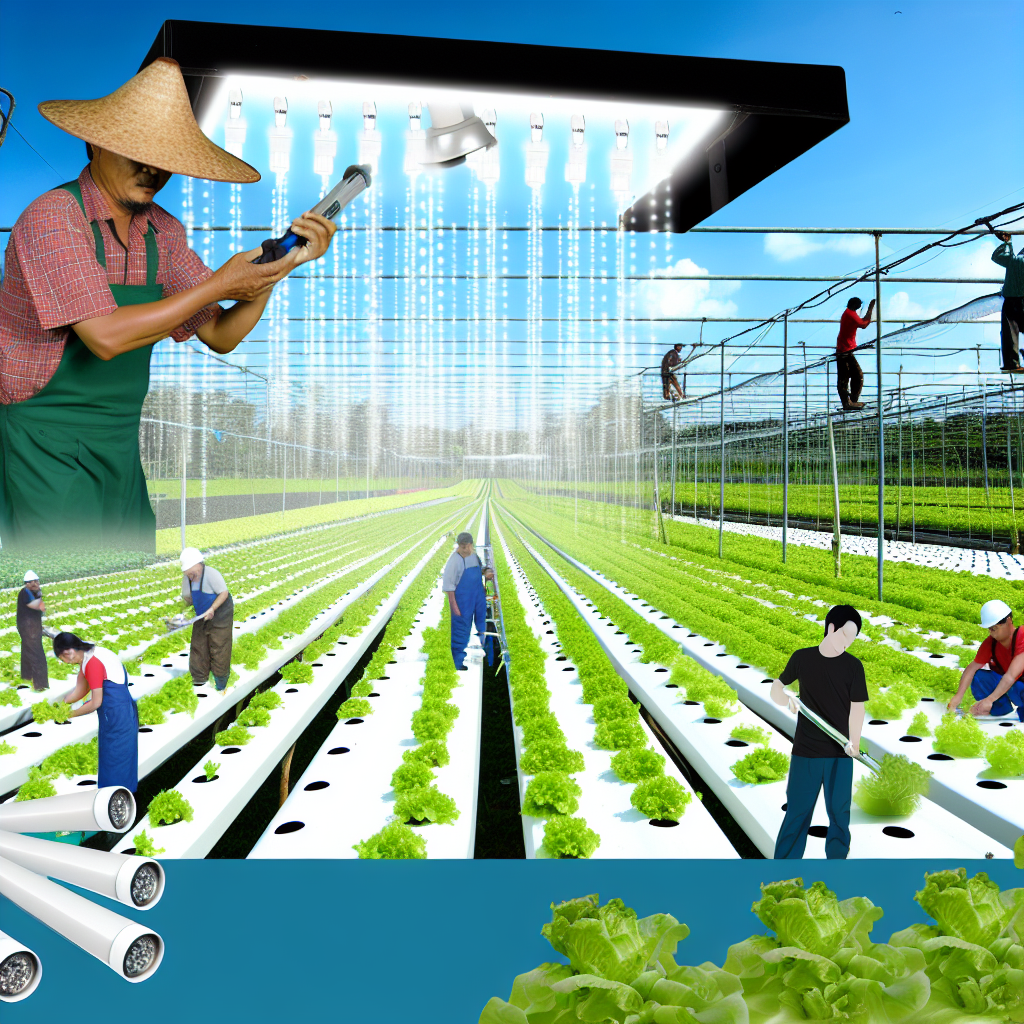Understanding the Basics of Hydroponics: A Beginner’s Guide
What is Hydroponics?
Hydroponics is a method of growing plants without soil.
Instead, it uses nutrient-rich water solutions.
This technique provides an efficient way to cultivate crops.
Benefits of Hydroponic Farming
Hydroponics offers several advantages over traditional farming.
First, it maximizes space and allows for vertical farming.
Second, it uses significantly less water than soil-based agriculture.
Additionally, it minimizes the risk of soil-borne diseases.
Moreover, plants grow faster due to controlled environments.
Essential Components of Hydroponic Systems
Several key components are vital for hydroponic farming.
- Grow lights help simulate sunlight for photosynthesis.
- Nutrient solutions provide essential minerals to plants.
- Water pumps circulate the nutrient solution effectively.
- Growing mediums support plant roots without soil.
Common Hydroponic Methods
Different methods cater to various types of plants and spaces.
- The nutrient film technique utilizes a thin film of nutrients.
- Deep water culture immerses plant roots directly in nutrient solution.
- Drip systems deliver nutrients at regulated intervals.
- Aeroponics suspends plants in air and mist their roots.
Starting Your Hydroponic Garden
Begin by selecting a suitable location for your setup.
Ensure it receives adequate light, temperature, and ventilation.
Next, choose your hydroponic system based on your needs.
Begin with easy-to-grow plants like lettuce or herbs.
Finally, monitor your system regularly for nutrient and pH levels.
Transform Your Agribusiness
Unlock your farm's potential with expert advice tailored to your needs. Get actionable steps that drive real results.
Get StartedAssessing Your Current Hydroponic System for Expansion Potential
Evaluating Your Existing Setup
Begin by analyzing your current hydroponic system.
Identify its strengths and weaknesses clearly.
Determine the types of crops you currently grow.
Assess the yield and quality of these crops.
This assessment lays the groundwork for successful scaling.
Understanding Space Utilization
Evaluate how effectively you use your available space.
Consider vertical farming options to maximize yields.
Utilizing vertical stacks optimizes your growing area.
Also, review light distribution across your system.
Good light exposure is crucial for healthy plant growth.
Analyzing Nutrient Management
Review your nutrient delivery system closely.
Identify areas where you might improve efficiency.
Incorporate advanced monitoring tools for better control.
Adequate nutrient management will boost production significantly.
Assessing Technical Capabilities
Evaluate the technology used in your hydroponic system.
Update outdated equipment to enhance performance.
Consider automation options to streamline processes.
Advanced technology can lead to noticeable efficiency gains.
Reviewing Financial Feasibility
Conduct a thorough financial analysis of expansion costs.
Identify potential funding sources for your growth initiative.
Consider grants, loans, or partnerships as options.
Understanding the financial landscape is essential before scaling.
Gathering Feedback and Input
Engage with your team for insights on improvements.
Encourage open discussions about potential issues.
Showcase Your Farming Business
Publish your professional farming services profile on our blog for a one-time fee of $200 and reach a dedicated audience of farmers and agribusiness owners.
Publish Your ProfileIncorporate feedback to formulate a solid expansion plan.
This collaborative approach enhances the effectiveness of your strategies.
Identifying Ideal Crops for Scaling
Understanding Crop Suitability
Choosing the right crops is crucial for scaling your hydroponic farm.
Consider the market demand for various crops.
Analyze climate conditions to ensure crop compatibility.
Additionally, assess the growth cycle of potential crops.
Evaluating Profitability
Profitability is a vital consideration when selecting crops.
Research the current market prices for different hydroponic crops.
Consider the cost of production against potential revenues.
Moreover, evaluate the popularity of crops in your target market.
Examining Space Requirements
Space efficiency significantly impacts crop selection.
Determine the growth space required for each crop.
Choose crops that maximize yield within your available area.
Furthermore, consider vertical farming options to save space.
Identifying Nutritional Value
Nutritional value can influence consumer choice.
Focus on crops that provide health benefits and vitamins.
Research trends in health-focused foods among consumers.
Additionally, consider growing organic crops for higher demand.
Seasonality and Crop Rotation
Seasonality plays a key role in crop selection.
Analyze seasonal trends to plan crop cycles effectively.
Consider rotating crops to maintain soil health and yield.
Moreover, this practice helps manage pests and diseases.
Delve into the Subject: Integrating Fruit Trees in Small Farms
Implementing Efficient Nutrient Management Strategies
Understanding Nutrient Requirements
Each plant species has unique nutrient needs.
Research these requirements to ensure optimal growth.
Utilize soil tests to guide nutrient application.
Additionally, consider the developmental stages of plants.
Choosing the Right Nutrient Solution
Select commercial nutrient solutions based on your crops.
Evaluate options for organic and synthetic alternatives.
Ensure the solution is balanced for the plant lifecycle.
Moreover, monitor pH levels to maintain nutrient availability.
Adopting Nutrient Delivery Systems
Hydroponic systems offer various nutrient delivery methods.
Consider using deep water culture or nutrient film technique.
Each method has advantages, so choose based on your farm’s needs.
Regularly check and maintain your delivery system for efficiency.
Implementing Monitoring and Adjustment Practices
Regular monitoring is essential for successful nutrient management.
Use tools like EC meters to gauge nutrient solution strength.
Adjust nutrient solutions based on real-time data.
This helps maintain optimal conditions for plant growth.
Integrating Technology for Efficiency
Modern hydroponic farms benefit from technological advancements.
Showcase Your Farming Business
Publish your professional farming services profile on our blog for a one-time fee of $200 and reach a dedicated audience of farmers and agribusiness owners.
Publish Your ProfileUtilize software for precise nutrient management tracking.
Automated systems can simplify nutrient delivery processes.
Furthermore, sensors can provide real-time data for adjustments.
Training and Educating Your Team
A well-informed team can significantly enhance nutrient management.
Conduct regular training sessions on nutrient application techniques.
Encourage staff to stay updated on best practices and innovations.
Additionally, share insights on the importance of nutrient management.
Learn More: Seed Storage Tips Every Farmer Should Know
Investing in Technology: Automation and Monitoring Systems
The Importance of Automation
Automation significantly boosts the efficiency of hydroponic farming.
It reduces labor costs and minimizes human error.
Consequently, farmers can allocate more time to strategic tasks.
Automated systems can control nutrient delivery and water levels.
This consistency enhances plant growth and yield.
Choosing the Right Monitoring Systems
Effective monitoring is critical for successful hydroponic farming.
Farmers should regularly assess environmental variables such as temperature.
Additionally, humidity and pH levels must be monitored closely.
Smart sensors can provide real-time data to farmers.
Consequently, adjustments can be made swiftly to optimize conditions.
Implementing IoT Solutions
Internet of Things (IoT) solutions offer advanced connectivity options.
They allow seamless integration of multiple devices within the farm.
Farmers can receive alerts about critical changes instantly.
This capability fosters proactive decision-making and risk management.
Evaluating Remote Monitoring Tools
Remote monitoring tools enhance accessibility for farmers.
Farmers can manage their systems from anywhere using mobile apps.
This flexibility leads to timely interventions when issues arise.
Additionally, it allows farmers to oversee multiple locations effectively.
Capitalizing on Data Analytics
Data analytics can provide insightful trends and forecasts.
Farmers can analyze historical data to improve future decisions.
Understanding patterns helps in effectively managing resources.
Consequently, this approach boosts overall farm productivity.
Investing for the Future
Initial investments in technology can pay off significantly.
Farmers should consider long-term benefits rather than just immediate costs.
Investing in innovation positions farmers to adapt to market demands.
Moreover, technology can lead to sustainable farming practices.
Ultimately, this investment prepares farmers for a competitive future.
See Related Content: DIY Seed Cleaning Methods For Farmers

Marketing Your Scaled Hydroponic Products
Understanding Your Target Market
Identifying your target market is crucial for success.
Research potential consumers who value freshness and sustainability.
Focus on urban dwellers who lack garden space.
Analyze preferences of health-conscious individuals.
Showcase Your Farming Business
Publish your professional farming services profile on our blog for a one-time fee of $200 and reach a dedicated audience of farmers and agribusiness owners.
Publish Your ProfileConsider business clients like restaurants and grocery stores.
Building a Strong Brand Identity
A recognizable brand identity sets you apart in the market.
Create a memorable logo that reflects your values.
Develop a unique value proposition that emphasizes freshness.
Ensure consistency across all marketing materials.
Utilize eco-friendly packaging to resonate with your audience.
Leveraging Social Media for Engagement
Social media platforms are vital for connecting with customers.
Utilize Instagram to showcase your vibrant produce visually.
Host live Q&A sessions for direct interaction with followers.
Share behind-the-scenes content to build transparency.
Encourage user-generated content by creating a unique hashtag.
Implementing Effective Marketing Strategies
Utilize email marketing to keep your audience informed.
Offer discounts and promotions to attract new customers.
Collaborate with local chefs for recipe ideas featuring your greens.
Participate in farmers’ markets to showcase your products.
Network with local businesses for cross-promotions.
Monitoring and Adapting Your Strategy
Regularly analyze sales data to evaluate your success.
Gather customer feedback to improve products and services.
Stay updated on industry trends for timely adjustments.
Be flexible in your approach to meet changing demands.
Continually refine your marketing strategy based on results.
See Related Content: Seasonal Maintenance Tips For Container Gardens
Financial Planning: Budgeting for Expansion and Scaling
Importance of Financial Planning
Financial planning is crucial for successful expansion.
It helps you set clear objectives for your hydroponic farm.
Additionally, it supports informed decision-making processes.
Effective budgeting allows you to anticipate costs proportionately.
Finally, it ensures your resources align with your growth goals.
Setting Realistic Budget Goals
Start by assessing current operational costs.
This includes expenses for equipment, utilities, and labor.
Next, estimate the costs associated with expansion.
Include factors such as new facility requirements or product diversification.
Moreover, factor in unexpected costs for contingency planning.
Creating a Detailed Budget Plan
Begin by categorizing all your expenses into fixed and variable costs.
Fixed costs remain constant, like rent and salaries.
Variable costs fluctuate, such as supplies and seasonal labor.
Subsequently, assign a percentage of your budget to each category.
This approach provides better tracking and management of finances.
Identifying Financial Resources
Explore various funding options for your expansion needs.
Consider loans, grants, and investor partnerships.
Government programs often support agricultural initiatives.
Showcase Your Farming Business
Publish your professional farming services profile on our blog for a one-time fee of $200 and reach a dedicated audience of farmers and agribusiness owners.
Publish Your ProfileAdditionally, look for private investors interested in sustainable agriculture.
Evaluating Loans and Grants
Research loan terms from banks or credit unions.
Understand interest rates and repayment plans thoroughly.
Explore available grants targeted towards hydroponics or sustainable farming.
Grants can significantly ease financial burdens during scaling efforts.
Monitoring and Adjusting Your Budget
Regularly review your budget to track expenses against projections.
Adjust forecasts as needed to accommodate unexpected changes.
Utilize financial tools to help automate tracking processes.
This can save time and enhance accuracy in financial management.
Implementing Performance Metrics
Establish metrics to measure financial performance effectively.
Key Performance Indicators (KPIs) allow you to gauge success.
Monitor growth trends and margins to assess operational efficiency.
Adjust strategies based on the insights gathered through monitoring.
Building a Support Network
Importance of Collaboration
Collaboration is essential for a successful hydroponic farm.
Working with other farmers can lead to shared knowledge.
Additionally, collaboration fosters community support.
This network can help resolve common challenges.
Connecting with Other Farmers
Join local farming cooperatives to expand your network.
These organizations provide resources and shared expertise.
Participate in community forums and workshops regularly.
Connect with farmers who share your vision and goals.
Engaging with Experts
Identify experts in hydroponics and related fields.
Consult with agricultural extension agents for guidance.
Attend conferences to learn from industry leaders.
Network with scientists focused on sustainable agriculture.
Utilizing Online Platforms
Social media is a powerful tool for networking.
Join online groups dedicated to hydroponic farming.
Share your experiences and ask for advice online.
Use platforms like LinkedIn to connect with professionals.
Benefits of a Strong Support Network
A robust network offers diverse perspectives on challenges.
It enhances your problem-solving abilities through collaboration.
Moreover, it can lead to viable partnerships and joint ventures.
This support system can significantly boost your farm’s success.




